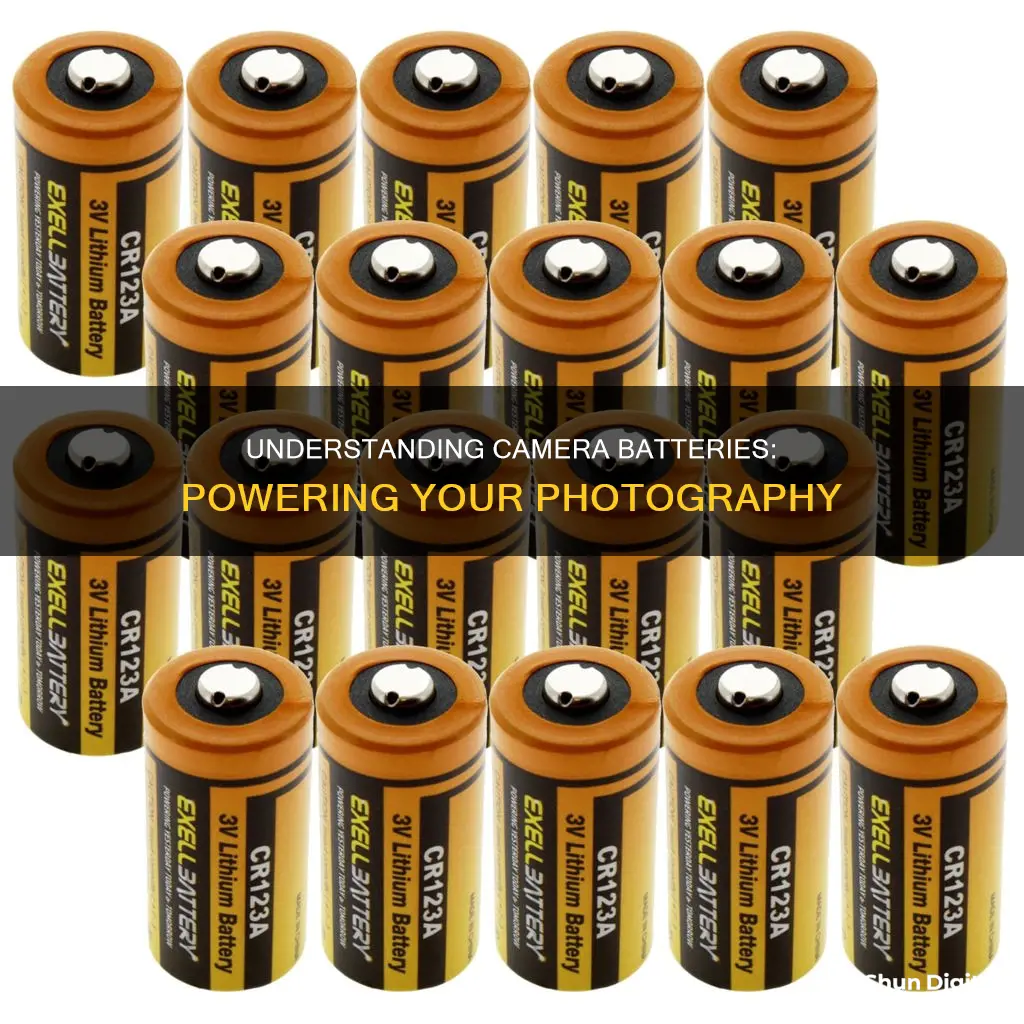
Camera batteries are the portable energy source for digital cameras. The ideal camera battery should offer high performance, long duration, and low environmental impact. Digital cameras require a robust power source, so most DSLRs and mirrorless cameras use rechargeable lithium-ion batteries. These batteries are small but have a large power capacity. They are also used in many other devices, such as cell phones, laptops, and electric vehicles.
While some cameras use universal battery formats such as AA or AAA, most require a specific type of battery. It is important to know your camera's needs and to check carefully before purchasing a new battery. Spare batteries are essential for photographers, especially when travelling or shooting long events.
| Characteristics | Values |
|---|---|
| Types | Lithium-Ion, Nickel-Metal-Hydride, Alkaline |
| Rechargeable | Yes, except for Alkaline batteries |
| Use | Digital cameras, flashlights, calculators, remote controls, smartphones, laptops, electric vehicles, hearing aids, power tools, high-tech gadgets |
| Shape and Size | Varied, some are universal like AA and AAA, while others are brand-specific |
| Voltage | 3V, 6V, 7.2V, 7.4V, 7.6V, 8.4V, 10.8V |
| Capacity | 1000mAh, 1100mAh, 1150mAh, 1200mAh, 1230mAh, 1240mAh, 1250mAh, 1500mAh, 1600mAh, 1720mAh, 2200mAh, 2250mAh, 2280mAh, 3500mAh |
| Weight | Varies, Lithium-Ion batteries are lighter |
| Temperature | Avoid extreme temperatures, store at room temperature |
What You'll Learn
- Camera batteries are usually rechargeable and need to be replaced when they get old
- Cameras with LCD displays and built-in flashguns are more power-hungry
- Carrying spare batteries is essential for photographers, especially when travelling
- Third-party batteries are widely available but may be poorly made and prone to losing charge
- Batteries come in different shapes and sizes and employ a range of chemical reactions to produce power

Camera batteries are usually rechargeable and need to be replaced when they get old
Camera batteries are a portable power source for your camera, and they come in different shapes and sizes. The ideal camera battery should offer high performance and long duration.
Digital cameras are considered high-drain devices, meaning that their batteries need to be changed or recharged often. Most digital cameras use rechargeable batteries, and there are many different types of rechargeable batteries available. Some of the most common types include lithium-ion (Li-ion) and nickel-metal-hydride (NiMH) batteries.
Li-ion batteries are the most common type of camera battery. They are lightweight, rechargeable, and capable of delivering a higher voltage than other battery types. They also have a large power capacity and are less prone to self-discharging when not in use. However, Li-ion batteries may need to be replaced when they get old, as rechargeable batteries can lose their ability to hold a full charge over time. It is also important to store Li-ion batteries at room temperature and avoid extreme temperatures to maintain their performance and longevity.
NiMH batteries are another option for digital cameras. They are rechargeable and have a high energy density, allowing them to store more energy in the same amount of space as traditional batteries. However, they are heavier than Li-ion batteries and are therefore less commonly used in camera battery packs.
When choosing a rechargeable battery for your camera, it is important to consider factors such as battery chemistry, capacity, and recharging process. Additionally, it is recommended to purchase batteries from reputable manufacturers to ensure safety and performance.
Keep Your Camera Battery-Ready: Why In-Camera Storage Matters
You may want to see also

Cameras with LCD displays and built-in flashguns are more power-hungry
Cameras with LCD screens and built-in flashguns have higher power requirements. To meet these demands, they typically use rechargeable lithium-ion batteries, which offer greater power capacity in a smaller package. These batteries are designed to last through numerous photo shoots, providing a reliable power source for capturing memories and special moments.
Lithium-ion batteries have become the standard for many digital cameras, including DSLRs and mirrorless cameras. Their small size and large power capacity make them ideal for photographers who need a lightweight setup without compromising on battery life. This is especially beneficial for long days of shooting or when travelling without access to frequent charging stations.
The rechargeable nature of lithium-ion batteries also aligns with the environmentally conscious approach that many photographers value. By opting for rechargeable batteries, photographers can reduce their environmental footprint and save money in the long run compared to disposable batteries.
It is worth noting that some cameras may still use disposable batteries, typically AA or AAA batteries. However, these are less common as the camera industry embraces the advantages of rechargeable options.
To ensure uninterrupted shooting, photographers often invest in extra batteries. This way, they can quickly swap out a depleted battery for a fully charged one, ensuring they don't miss a moment due to a lack of power.
In addition to the battery itself, proper care and maintenance are crucial for optimal performance. Following best practices, such as using the correct battery charger and avoiding extreme temperatures, can extend the lifespan of camera batteries and ensure they reliably power the camera's functions, including the LCD display and built-in flashgun.
Charging Your Campark: A Step-by-Step Guide
You may want to see also

Carrying spare batteries is essential for photographers, especially when travelling
Camera batteries are portable energy sources that power digital cameras. Most modern cameras use rechargeable lithium-ion batteries, which are lightweight and powerful, making them ideal for photography. Carrying spare batteries is essential for photographers, especially when travelling, to ensure they can continue shooting without access to a power source or battery charger.
Lithium-ion batteries are commonly used in digital cameras due to their small size and large power capacity. They are also widely used in other devices, such as smartphones, laptops, and electric vehicles. While lithium-ion batteries are generally safe, there is a risk of overheating and fire if they are not handled properly. To minimise this risk, photographers should take precautions when carrying spare batteries, especially when travelling.
When travelling with spare camera batteries, it is important to follow guidelines from organisations such as the FAA (Federal Aviation Administration) and TSA (Transportation Security Administration). These guidelines include restrictions on the type, quantity, and capacity of batteries allowed on flights. For example, spare lithium-ion batteries are typically limited to two per passenger, and they must be carried in carry-on luggage rather than checked baggage. This is because lithium-ion batteries pose a fire risk if they are not handled carefully, and having them in the cabin allows for easier access in case of an issue.
To further reduce the risk of fire, photographers should also take steps to protect their spare camera batteries from damage and short circuits. This includes keeping the batteries in their original packaging or using tape to cover the battery terminals. Additionally, it is important to regularly inspect battery compartments for leaks and to remove batteries from equipment when it will not be used for an extended period.
By following these guidelines and taking the necessary precautions, photographers can ensure they have access to the power they need to capture memorable shots without putting themselves or others at risk.
Charging Camera Batteries: Alone Contestants' Strategies
You may want to see also

Third-party batteries are widely available but may be poorly made and prone to losing charge
Camera batteries are the portable power source for digital cameras. While film cameras typically use disposable batteries, most digital cameras now feature rechargeable batteries.
When shopping for camera batteries, you'll be faced with two options: buying an official" battery from the camera's manufacturer, or opting for a cheaper third-party alternative. Third-party batteries are widely available, but there are some potential drawbacks to consider.
Third-party batteries can be a mixed bag. Even with positive reviews, an off-brand battery may not live up to the capacity or lifespan of an official battery. They might struggle to hold a charge or need replacing after a year. That being said, some reputable third-party manufacturers, such as Wasabi and SterlingTek, produce batteries that work as expected and are known for good customer service.
If you're considering third-party batteries, it's important to do your research. Check reviews and testimonials to ensure you're choosing a well-known brand. Avoid buying from unknown brands or untrustworthy retailers, as this increases the risk of ending up with a counterfeit product. It's also recommended to stick with trusted retailers like B&H or in-person stores like Best Buy, rather than purchasing from Amazon, where counterfeits are more common.
While it's unlikely that a third-party battery will damage your camera, it's important to be aware of the risks. The main concern is the potential for swelling or exploding batteries, which can occur with any lithium-ion battery, regardless of its brand. However, it's worth noting that manufacturer warranties typically do not cover damage caused by third-party batteries or accessories.
Charging Your Canon Camera Battery: A Step-by-Step Guide
You may want to see also

Batteries come in different shapes and sizes and employ a range of chemical reactions to produce power
Camera batteries come in a variety of shapes and sizes, and they can be disposable or rechargeable. Disposable batteries, also known as primary batteries, are used once and then discarded as their electrode materials are irreversibly changed during discharge. Common examples include alkaline batteries used in flashlights and portable electronic devices. On the other hand, rechargeable batteries, or secondary batteries, can be discharged and recharged multiple times using an applied electric current. Examples include lead-acid batteries used in vehicles and lithium-ion batteries used in laptops and mobile phones.
The shape and size of camera batteries vary depending on the camera model and manufacturer. For instance, Canon batteries come in different shapes and sizes suitable for specific Canon camera product lines. Generic batteries are also available, which have the same shape and size as branded batteries.
The most common type of rechargeable battery for DSLRs is the lithium-ion battery. These batteries are more powerful, lighter, and less affected by cold weather. Most rechargeable batteries come in brand-specific formats. Similar to lithium-ion batteries, NiMH batteries are also rechargeable and offer a high energy density, allowing them to store two to three times more energy than traditional batteries in the same amount of space.
The performance of camera batteries depends on various factors, including internal chemistry, current drain, and temperature. At low temperatures, batteries cannot deliver as much power, and their performance decreases. Therefore, in cold climates, car owners often use battery warmers to keep their vehicle batteries warm.
The complex chemical processes within batteries are still being studied by scientists, even though batteries were invented over two centuries ago. These processes involve the conversion of electrical energy into chemical potential energy for storage and vice versa. The chemical reactions in a battery involve the flow of electrons from one electrode to another through an external circuit, facilitated by an electrolyte solution.
Finding the Remaining Battery Life on Your Canon SX10 IS
You may want to see also
Frequently asked questions
Camera batteries are portable energy sources that power digital cameras. They are designed to provide high performance and long-lasting use while minimising environmental impact.
There are two main types of camera batteries: rechargeable and non-rechargeable. Rechargeable batteries include lithium-ion (Li-ion) and nickel-metal-hydride (NiMH) batteries, while non-rechargeable batteries typically refer to disposable AA or AAA batteries.
When choosing a camera battery, consider the power delivery, duration, and recharging capabilities. Additionally, factors like temperature and storage conditions can impact battery performance. It's also important to select batteries compatible with your specific camera model, as different cameras have unique power requirements.







